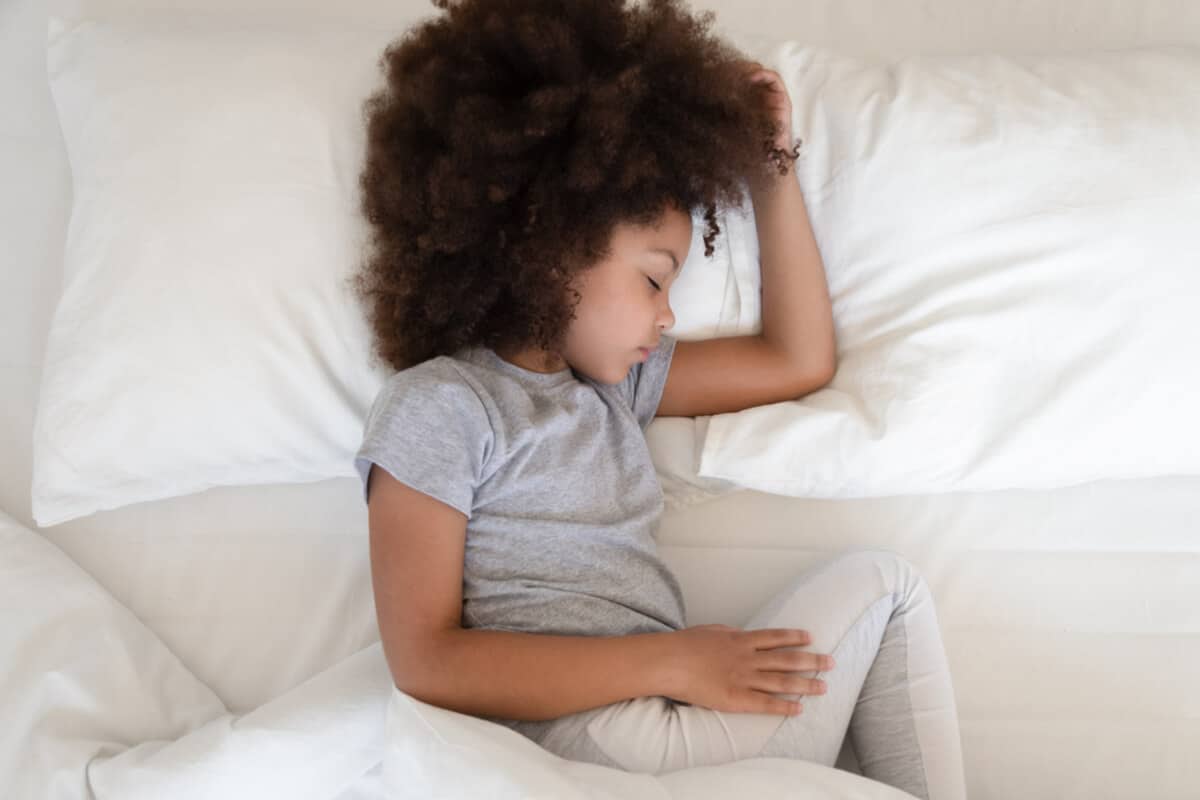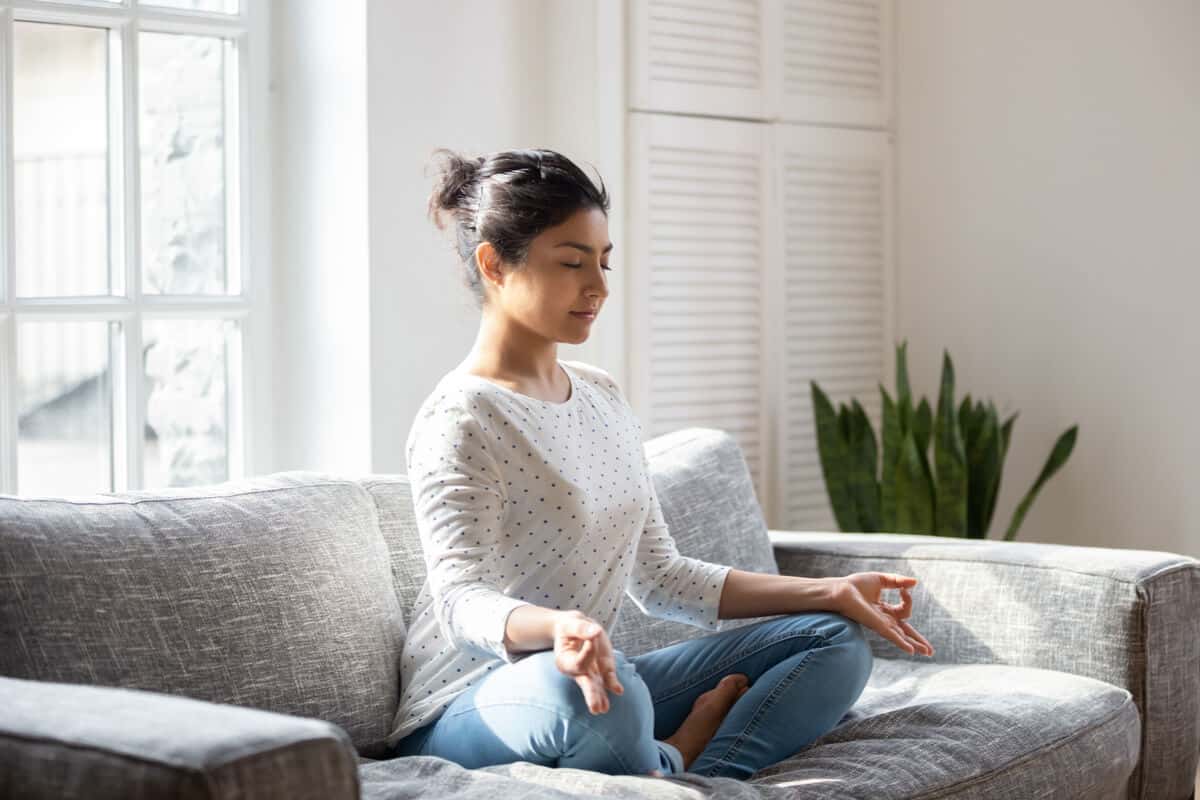
Valerian root contains compounds such as valerenic acid, isovaleric acid, and antioxidants.
What is valerian root?
Valerian is a flowering herb native to Asia and Europe, but it is now grown all over the world. In optimal growing conditions, a mature plant can grow up to five feet tall, bearing delicate pink and white flowers. The strong root system of this plant is the part most commonly used as a medicinal remedy. There is no shortage of ways to consume the relaxing herb; it is available as valerian root tea, tinctures, capsules, or tablets. The root itself contains several active compounds, such as valerenic acid, isovaleric acid, and antioxidants, which are believed to be responsible for its health benefits. (3)(14)Valerian root benefits
Valerian root is consumed for its numerous benefits of increasing well-being and sleep quality. The specific mechanism in which valerian root calms anxiety and promotes a restful sleep is largely unknown, but research suggests that it could be due to the effect it has on gamma-Aminobutyric acid (GABA) transmission and receptors. (5)(18) GABA is an amino acid that acts as a neurotransmitter in the brain, a chemical messenger that communicates between the brain and the nervous system. GABA is commonly known for its ability to induce a calming effect in the body. (32) Studies have shown that low levels of GABA can be related to symptoms of anxiety and poor sleep quality. (22)(37) Valerian contains a number of compounds that may help promote rest and relaxation. Specifically, the valerenic acid found in valerian root has been studied for its ability to inhibit the breakdown of GABA in the brain, promoting relaxation. (3)(14) Additionally, hesperidin and linarin are antioxidants found in valerian that have shown to promote a good night’s sleep. (12)
Valerian can be an effective remedy for improving sleep disturbances and reducing sleep latency.
Valerian root for sleep
Approximately 30% of the adult population around the world experiences recurring insomnia, impairing both physical and cognitive functioning and affecting overall well-being. (31) If you struggle with insomnia or other sleep issues, consuming valerian root as a remedy may be effective for improving sleep quality and duration. (6) Valerian may be effective in improving overall sleep quality, with one study showing that 44% of participants reported perfect sleep and 89% reported an improvement in their sleep disturbances. (21) Research has shown that therapeutic doses of valerian root can also reduce sleep latency, the time it takes for an individual to fall asleep, in individuals struggling with mild sleep disturbances and insomnia. (2)(10)(20) Valerian root has also been studied for its effects specifically on women who are struggling with sleep disruptions related to menopause and postmenopause, concluding that valerian may be an effective remedy for reducing sleeping disturbances related to these stages of life. (33)(34)
Valerian root supplementation has been shown to reduce symptoms related to stress and anxiety.
Valerian for anxiety and stress
Stress and anxiety are likely to affect us all at some point in our lives. Numerous studies have examined valerian root’s ability to reduce anxious feelings related to stressful events in our lives, suggesting it may be an effective alternative to anxiolytics (anti-anxiety medication), perhaps with a reduced risk of associated side effects. (7)(9)(24) One study examined the anxiolytic properties of valerian when combined with lemon balm and concluded that consuming these two herbs together may have anti-anxiety effects. (17) On its own, valerian extract has been shown to effectively reduce symptoms in individuals who struggle with generalized anxiety disorder. (1) Valerian root may also benefit individuals with obsessive-compulsive disorder (OCD), a common neuropsychiatric condition associated with anxious behaviors. The effect of valerian on OCD may be attributed to its GABA-regulating properties. One eight-week double-blind, randomized trial found that individuals supplementing with valerian demonstrated anti-obsessive and anti-compulsive effects after therapeutic dosing. (27)Other benefits of valerian root
While sleep and anxiety are the most widely studied applications of valerian, this medicinal herb may also provide other benefits, including:- Increased focus in children with hyperactive behaviors and restlessness (13)(23)(30)
- Reduced hot flashes related to menopause (15)(35)
- Reduced symptoms related to premenstrual syndrome (PMS), such as mood disturbances and uterine cramping (4)(28)
- Reduced symptoms related to restless leg syndrome (8)
Valerian root side effects and clinical interactions
Research suggests that valerian supplementation appears to cause few side effects when used for both sleep disturbances and anxiety. Valerian root extract has specifically been studied for its potential side effects on alertness, concentration, and reaction time. (36) A randomized controlled, double-blind trial concluded that individuals who consumed valerian root extract before bed didn’t appear to be impaired upon awakening the next morning. (19) Additionally, valerian has been shown to decrease withdrawal side effects from benzodiazepines, a class of medications used to treat insomnia. (29) Valerian root has also been shown to have limited to no evidence of clinical interactions. When used therapeutically for patients undergoing cancer therapy or taking anti-cancer drugs, valerian presented no relevant interactions. (16) Valerian has also been shown to have little to no effect on specific drug-metabolizing enzymes needed to metabolize certain medications such as dextromethorphan and alprazolam, suggesting it may be safe to consume with certain pharmaceuticals. (11) If you are pregnant or breastfeeding, have a pre-existing medical condition, or are taking a pharmaceutical medication, please contact your integrative healthcare professional if you are considering adding valerian root supplementation to your routine.The bottom line
Used for centuries in places all around the world, valerian root’s historical use as a calming remedy is supported by modern-day research. Whether you struggle with getting a good night’s sleep, generalized anxiety, or hormonal challenges such as PMS or menopause, valerian may be effective in improving symptoms and supporting optimal quality of life.- Andreatini, R., Sartori, V. A., Seabra, M. L. V., & Leite, J. R. (2002). Effect of valepotriates (valerian extract) in generalized anxiety disorder: a randomized placebo-controlled pilot study. Phytotherapy Research, 16(7), 650–654. https://doi.org/10.1002/ptr.1027(25/30)
- Balderer, G., & Borbly, A. A. (1985). Effect of valerian on human sleep. Psychopharmacology, 87(4), 406–409. https://doi.org/10.1007/bf00432503(20)
- Becker, A., Felgentreff, F., Schröder, H., Meier, B., & Brattström, A. (2014). The anxiolytic effects of a Valerian extract is based on Valerenic acid. BMC Complementary and Alternative Medicine, 14(1), 1. https://doi.org/10.1186/1472-6882-14-267(7/13)
- Behboodi Moghadam, Z., Rezaei, E., Shirood Gholami, R., Kheirkhah, M., & Haghani, H. (2016). The effect of Valerian root extract on the severity of pre menstrual syndrome symptoms. Journal of Traditional and Complementary Medicine, 6(3), 309–315. https://doi.org/10.1016/j.jtcme.2015.09.001(39)
- Benke, D., Barberis, A., Kopp, S., Altmann, K.-H., Schubiger, M., Vogt, K. E., Rudolph, U., & Möhler, H. (2009). GABAA receptors as in vivo substrate for the anxiolytic action of valerenic acid, a major constituent of valerian root extracts. Neuropharmacology, 56(1), 174–181. https://doi.org/10.1016/j.neuropharm.2008.06.013(8)
- Bent, S., Padula, A., Moore, D., Patterson, M., & Mehling, W. (2006). Valerian for Sleep: A Systematic Review and Meta-Analysis. The American Journal of Medicine, 119(12), 1005–1012. https://doi.org/10.1016/j.amjmed.2006.02.026(1/4/18)
- Cropley, M., Cave, Z., Ellis, J., & Middleton, R. W. (2002). Effect of Kava and Valerian on human physiological and psychological responses to mental stress assessed under laboratory conditions. Phytotherapy Research, 16(1), 23–27. https://doi.org/10.1002/ptr.1002(28)
- Cuellar, N. (2009). Valeriana officinalis (valerian) may help patients with restless legs syndrome. Focus on Alternative and Complementary Therapies, 14(3), 179–180. https://doi.org/10.1211/fact.14.3.0007(40)
- Del Valle-Mojica, L., & Ortíz, J. (2012). Anxiolytic Properties of Valeriana officinalis in the Zebrafish: A Possible Role for Metabotropic Glutamate Receptors. Planta Medica, 78(16), 1719–1724. https://doi.org/10.1055/s-0032-1315240(27)
- Donath, F., Quispe, S., Diefenbach, K., Maurer, A., Fietze, I., & Roots, I. (2000). Critical Evaluation of the Effect of Valerian Extract on Sleep Structure and Sleep Quality. Pharmacopsychiatry, 33(2), 47–53. https://doi.org/10.1055/s-2000-7972(22)
- Donovan, J. L., DeVane, C. L., Chavin, K. D., Wang, J.-S., Gibson, B. B., Gefroh, H. A., & Markowitz, J. S. (2004). MULTIPLE NIGHT-TIME DOSES OF VALERIAN (Valeriana officinalis) HAD MINIMAL EFFECTS ON CYP3A4 ACTIVITY AND NO EFFECT ON CYP2D6 ACTIVITY IN HEALTHY VOLUNTEERS. Drug Metabolism and Disposition, 32(12), 1333–1336. https://doi.org/10.1124/dmd.104.001164(45)
- Fernández, S., Wasowski, C., Paladini, A. C., & Marder, M. (2004). Sedative and sleep-enhancing properties of linarin, a flavonoid-isolated from Valeriana officinalis. Pharmacology Biochemistry and Behavior, 77(2), 399–404. https://doi.org/10.1016/j.pbb.2003.12.003(15)
- Gromball, J., Beschorner, F., Wantzen, C., Paulsen, U., & Burkart, M. (2014). Hyperactivity, concentration difficulties and impulsiveness improve during seven weeks’ treatment with valerian root and lemon balm extracts in primary school children. Phytomedicine, 21(8–9), 1098–1103. https://doi.org/10.1016/j.phymed.2014.04.004(34)
- HOUGHTON, P. J. (1999). The Scientific Basis for the Reputed Activity of Valerian. Journal of Pharmacy and Pharmacology, 51(5), 505–512. https://doi.org/10.1211/0022357991772772(5/6/14)
- Jenabi, E., Shobeiri, F., Hazavehei, S. M. M., & Roshanaei, G. (2017). The effect of Valerian on the severity and frequency of hot flashes: A triple-blind randomized clinical trial. Women & Health, 58(3), 297–304. https://doi.org/10.1080/03630242.2017.1296058(36)
- Kelber, O., Nieber, K., & Kraft, K. (2014). Valerian: No Evidence for Clinically Relevant Interactions. Evidence-Based Complementary and Alternative Medicine, 2014, 1–8. https://doi.org/10.1155/2014/879396(44)
- Kennedy, D. O., Little, W., Haskell, C. F., & Scholey, A. B. (2006). Anxiolytic effects of a combination ofMelissa ofcinalis andValeriana ofcinalis during laboratory induced stress. Phytotherapy Research, 20(2), 96–102. https://doi.org/10.1002/ptr.1787(29)
- Khom, S., Strommer, B., Ramharter, J., Schwarz, T., Schwarzer, C., Erker, T., Ecker, G. F., Mulzer, J., & Hering, S. (2010). Valerenic acid derivatives as novel subunit-selective GABAA receptor ligands -in vitro and in vivo characterization. British Journal of Pharmacology, 161(1), 65–78. https://doi.org/10.1111/j.1476-5381.2010.00865.x(9)
- Kuhlmann, J., Berger, W., Podzuweit, H., & Schmidt, U. (1999). The Influence of Valerian Treatment on “Reaction Time, Alertness and Concentration” in Volunteers. Pharmacopsychiatry, 32(06), 235–241. https://doi.org/10.1055/s-2007-991100(42)
- Leathwood, P. D., Chauffard, F., Heck, E., & Munoz-Box, R. (1982). Aqueous extract of valerian root (Valeriana officinalis L.) improves sleep quality in man. Pharmacology Biochemistry and Behavior, 17(1), 65–71. https://pubmed.ncbi.nlm.nih.gov/7122669/
- Lindahl, O., & Lindwall, L. (1989). Double blind study of a Valerian preparation. Pharmacology Biochemistry and Behavior, 32(4), 1065–1066. https://doi.org/10.1016/0091-3057(89)90082-8(16/19)
- Meyerhoff, D. J., Mon, A., Metzler, T., & Neylan, T. C. (2014). Cortical Gamma-Aminobutyric Acid and Glutamate in Posttraumatic Stress Disorder and Their Relationships to Self-Reported Sleep Quality. Sleep, 37(5), 893–900. https://doi.org/10.5665/sleep.3654(11)
- Müller, S. F., & Klement, S. (2006). A combination of valerian and lemon balm is effective in the treatment of restlessness and dyssomnia in children. Phytomedicine, 13(6), 383–387. https://doi.org/10.1016/j.phymed.2006.01.013(33)
- Murphy, K., Kubin, Z. J., Shepherd, J. N., & Ettinger, R. H. (2010). Valeriana officinalis root extracts have potent anxiolytic effects in laboratory rats. Phytomedicine, 17(8–9), 674–678. https://doi.org/10.1016/j.phymed.2009.10.020(26)
- Nandhini, S., Narayanan, K. B., & Ilango, K. (2018). VALERIANA OFFICINALIS: A REVIEW OF ITS TRADITIONAL USES, PHYTOCHEMISTRY AND PHARMACOLOGY. Asian Journal of Pharmaceutical and Clinical Research, 11(1), 36. https://doi.org/10.22159/ajpcr.2017.v11i1.22588(3)
- Office of Dietary Supplements – Valerian. (2013). National Institutes of Health. https://ods.od.nih.gov/factsheets/Valerian-HealthProfessional/#en9
- Pakseresht, S., Boostani, H., & Sayyah, M. (2011). Extract of Valerian Root (Valeriana Officinalis L.) vs. Placebo in Treatment of Obsessive-Compulsive Disorder: A Randomized Double-Blind Study. Journal of Complementary and Integrative Medicine, 8(1), 1. https://doi.org/10.2202/1553-3840.1465(31/32)
- Pino, A., Palumbo, D. R., Samperi, S., De Pasquale, R., Sturlese, E., Circosta, C., & Occhiuto, F. (2009). Relaxing effects of Valeriana officinalis extracts on isolated human non-pregnant uterine muscle. Journal of Pharmacy and Pharmacology, 61(2), 251–256. https://doi.org/10.1211/jpp/61.02.0016(38)
- Poyares, D. R., Guilleminault, C., Ohayon, M. M., & Tufik, S. (2002). Can valerian improve the sleep of insomniacs after benzodiazepine withdrawal? Progress in Neuro-Psychopharmacology and Biological Psychiatry, 26(3), 539–545. https://doi.org/10.1016/s0278-5846(01)00305-0(43)
- Ross, S. M. (2015). Valerian Root and Lemon Balm Extracts. Holistic Nursing Practice, 29(6), 391–395. https://doi.org/10.1097/hnp.0000000000000118(35)
- Roth, T. (2007). Insomnia: Definition, Prevalence, Etiology, and Consequences. Journal of Clinical Sleep Medicine, 3(5 suppl), 1. https://doi.org/10.5664/jcsm.26929(17)
- Shelp, B. (1999). Metabolism and functions of gamma-aminobutyric acid. Trends in Plant Science, 4(11), 446–452. https://doi.org/10.1016/s1360-1385(99)01486-7(10)
- Taavoni, S., Ekbatani, N., Kashaniyan, M., & Haghani, H. (2011). Effect of valerian on sleep quality in postmenopausal women. Menopause, 18(9), 951–955. https://doi.org/10.1097/gme.0b013e31820e9acf(24)
- Taavoni, S., Nazem ekbatani, N., & Haghani, H. (2013). Valerian/lemon balm use for sleep disorders during menopause. Complementary Therapies in Clinical Practice, 19(4), 193–196. https://doi.org/10.1016/j.ctcp.2013.07.002(23)
- The Effects of Valerian Root on Hot Flashes in Menopausal Women. (2012). PubMed Central (PMC). https://www.ncbi.nlm.nih.gov/pmc/articles/PMC3813196/(37)
- Thomas, K., Canedo, J., Perry, P. J., Doroudgar, S., Lopes, I., Chuang, H. M., & Bohnert, K. (2016). Effects of valerian on subjective sedation, field sobriety testing and driving simulator performance. Accident Analysis & Prevention, 92, 240–244. https://doi.org/10.1016/j.aap.2016.01.019(41)
- Winkelman, J. W., Buxton, O. M., Jensen, J. E., Benson, K. L., O’Connor, S. P., Wang, W., & Renshaw, P. F. (2008). Reduced Brain GABA in Primary Insomnia: Preliminary Data from 4T Proton Magnetic Resonance Spectroscopy (1H-MRS). Sleep, 31(11), 1499–1506. https://doi.org/10.1093/sleep/31.11.1499(12)





